El hilo de bordar metálico añade un toque de elegancia y glamour a cualquier proyecto de bordado.. Sin embargo, Los bordadores a menudo se enfrentan al frustrante problema de la rotura del hilo cuando utilizan hilos metálicos..
Ya seas un principiante o un bordador experimentado, Comprender las razones detrás de este problema y aprender cómo prevenirlo puede ahorrarle tiempo., esfuerzo, y frustración.
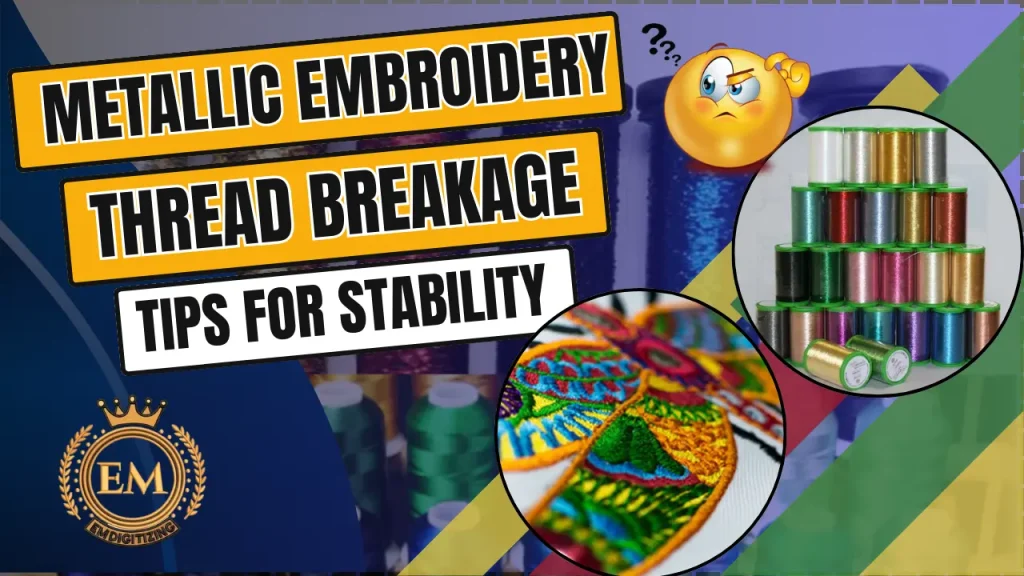
En este articulo, Nos adentraremos en el mundo del hilo metálico y exploraremos las causas comunes de rotura del hilo..
10 Razones convincentes por las que necesita la digitalización de bordados personalizados
¿Qué es un hilo de bordar metálico??
If you’;alguna vez he visto esos brillantes, hilos llamativos que añaden un toque de glamour a proyectos de bordado, then you’;Probablemente estés familiarizado con este tipo de hilo..
El hilo metálico es un tipo de hilo especial que está hecho con un núcleo de poliéster o nailon y envuelto con una lámina metálica. Viene en varios colores y añade un hermoso brillo a los diseños de bordado..
Tipos de hilo de bordar metálico
Existen diferentes tipos de hilos metálicos disponibles en el mercado., cada uno con sus propias características únicas. Algunos tipos populares incluyen:
Hilo metálico liso: Este tipo de hilo metálico tiene una textura suave y es ideal para añadir un brillo sutil a los proyectos de bordado..
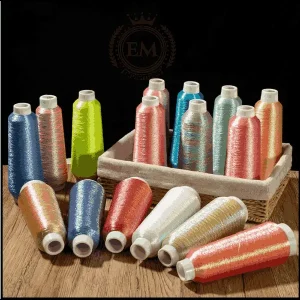
Hilo metálico texturizado: If you’;Estamos buscando un efecto más pronunciado., texturizado hilo metalico es el camino a seguir. Tiene una superficie texturizada que refleja la luz maravillosamente y crea una apariencia más dramática.. Por ejemplo, hilo de bordar dorado metalizado.
Hilo metálico mezclado: El hilo metálico mezclado combina fibras metálicas y no metálicas., dando como resultado un hilo con una textura y apariencia únicas. It’;Es perfecto para crear dimensión y profundidad en diseños de bordado.
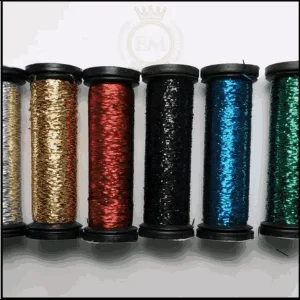
Razones comunes por las que se rompe el hilo de bordar metálico
Este tipo de rotura de hilo es un problema común que puede frustrar incluso a los bordadores más experimentados., A menudo se atribuye a sus propiedades únicas y a las exigencias de trabajar con él..
Mala calidad del hilo
Una de las razones más comunes por las que el hilo metálico se rompe es por la mala calidad del hilo.. Es posible que los hilos baratos o de baja calidad no sean lo suficientemente fuertes para soportar los rigores del bordado., provocando frecuentes roturas.
Invertir en hilo metálico de alta calidad puede marcar una gran diferencia en la durabilidad de sus puntadas..
Tensión incorrecta del hilo
tensión del hilo juega un papel crucial en el bordado, Y el hilo metálico no es una excepción.. Si la tensión es demasiado apretada, puede ejercer una tensión excesiva sobre el hilo, causando que se rompa.
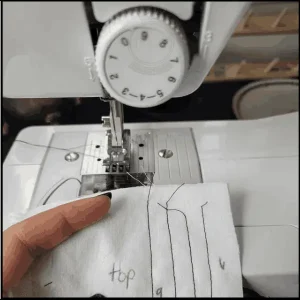
Por otro lado, si la tensión es demasiado floja, Es posible que el hilo no esté correctamente asegurado en la tela., resultando en rotura. Encontrar el equilibrio adecuado es clave para evitar la rotura del hilo.
Selección inadecuada de agujas
Elegir la aguja adecuada es esencial para un bordado exitoso, y usar la aguja incorrecta puede provocar la rotura del hilo..
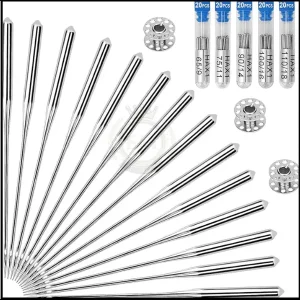
Cuando se trabaja con hilo metálico., it’;Es importante seleccionar una aguja que tenga un ojo más grande para adaptarse al grosor del hilo..
Usar una aguja con un ojo pequeño puede causar fricción y romper las delicadas fibras metálicas..
Manejo y almacenamiento inadecuados
La forma en que maneja y almacena su hilo metálico también puede afectar su durabilidad.. Manejo rudo, como tirar o tirar del hilo, puede debilitarlo y aumentar la probabilidad de rotura.
Similarmente, El almacenamiento inadecuado en condiciones húmedas o mojadas puede causar que la lámina metálica se deteriore., haciendo que el hilo sea más propenso a romperse. Trate su hilo metálico con cuidado y guárdelo en un lugar fresco., lugar seco para mantener su calidad.
La tensión del hilo y su impacto en el hilo de bordar metálico
La tensión del hilo juega un papel fundamental en el rendimiento del hilo metálico., Influyendo directamente en la calidad de la puntada y en la probabilidad de rotura del hilo..
Comprender la importancia de la tensión del hilo
La tensión del hilo se refiere a la cantidad de resistencia que se aplica al hilo cuando pasa a través de la tela..
Es crucial en el bordado porque determina la apariencia y durabilidad de los puntos.. La tensión adecuada garantiza que las puntadas se formen de manera uniforme y segura., reduciendo las posibilidades de rotura del hilo.
Ajuste de la tensión del hilo para hilo metálico
Cuando se trabaja con hilo metálico., it’;Es importante ajustar la tensión del hilo para adaptarlo a sus propiedades únicas..
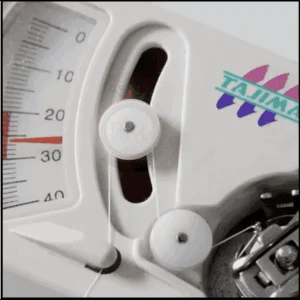
Generalmente, Aflojar ligeramente la tensión puede ayudar a reducir la tensión en el hilo y minimizar la rotura..
Sin embargo, it’;Es esencial probar diferentes ajustes de tensión en tela sobrante antes de comenzar su proyecto para encontrar el equilibrio óptimo..
Selección de agujas y su papel en la reducción de la rotura del hilo
La selección de la aguja es un factor crítico para minimizar la rotura del hilo., especialmente cuando se trabaja con materiales delicados como hilo metálico.
Elegir la aguja adecuada
Seleccionar el tipo de aguja correcto es crucial para evitar la rotura del hilo cuando se trabaja con hilo metálico.. Opte por una aguja diseñada específicamente para hilos metálicos., ya que tienen ojos más grandes y superficies más suaves para minimizar la fricción.
Estas agujas permiten que el hilo se deslice suavemente por la tela., reduciendo las posibilidades de rotura.
Tamaño de la aguja y su impacto en la rotura del hilo
Otro factor a considerar es el tamaño de la aguja.. Elegir una aguja demasiado pequeña puede ejercer una presión excesiva sobre el hilo metálico., llevando a la rotura.
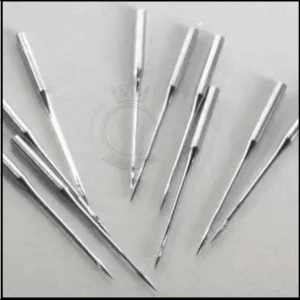
Por otro lado, Usar una aguja demasiado grande puede hacer que el hilo se resbale y se enrede..
Experiment with different needle sizes to find the one that works best for the specific metallic thread you’;re usando.
Por otro lado, using a needle that is too large can cause the thread to slip and tangle. ;
Experiment with different needle sizes to find the one that works best for the specific metallic thread you’;re usando.
Técnicas adecuadas de manipulación y almacenamiento del hilo de bordar metálico
El manejo y almacenamiento adecuados al bordar con hilo metálico son clave para preservar su calidad y minimizar problemas como enredos y roturas..
Precauciones al manipular este hilo
Cuando se trata de bordados metálicos, un poco de cuidado extra ayuda mucho. Estas hebras brillantes pueden ser un poco delicadas, so it’;Es importante manejarlos con precaución..
Aquí hay algunas precauciones a tener en cuenta.:
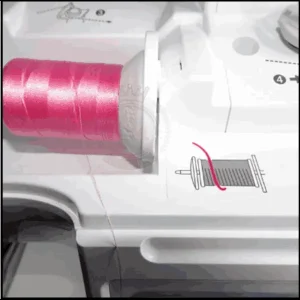
- Evite tirar o tirar del hilo con demasiada fuerza.. El hilo metálico es más delicado que el hilo de bordar normal., así que trate de manipularlo con cuidado para evitar que se rompa..
- Tenga cuidado con los bordes afilados o las superficies rugosas en las que el hilo podría engancharse.. If you’;Estamos trabajando en un proyecto que tiene elementos propensos a engancharse., considere usar un tipo diferente de hilo.
- Mantén tus manos limpias y secas.. Aceites, lociones, and sweat can reduce the thread’;s fuerza y hacer que se rompa más fácilmente.
Almacenamiento correcto del hilo metálico
Almacenar correctamente el hilo metálico puede ayudar a prolongar su vida útil y reducir las posibilidades de rotura.. A continuación se ofrecen algunos consejos para mantener su hilo en óptimas condiciones.:
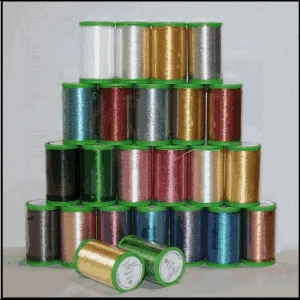
- Guarde su hilo metálico en un lugar fresco., lugar seco lejos de la luz solar directa. El calor o la humedad excesivos pueden hacer que el hilo se vuelva quebradizo o pierda color..
- Evite enrollar el hilo con fuerza alrededor de carretes o bobinas.. En cambio, Considere usar un estante para hilos o un organizador de hilos para evitar enredos y minimizar la tensión en el hilo..
- If you’;No vas a usar el hilo por un período prolongado., Considere sellarlo en un recipiente hermético para protegerlo del polvo y la humedad..
Consejos y trucos para prevenir la rotura del hilo de bordar metálico
Superar los desafíos de este tipo de rotura de hilo requiere una combinación de conocimiento y técnica..
Usar lubricantes o acondicionadores
Algunas veces, un poco de lubricación puede ser de gran ayuda para prevenir la rotura del hilo. Puedes intentar aplicar una pequeña cantidad de acondicionador de hilo o lubricante de silicona al hilo metálico antes de usarlo..
Esto puede ayudar a reducir la fricción y minimizar las posibilidades de rotura a medida que el hilo se desliza a través de la tela..
Minimizar la fricción durante el bordado
La fricción es enemiga del hilo metálico.. Para minimizar este molesto enemigo, puedes probar las siguientes técnicas:
- Utilice una aguja más grande con un ojo más grande.. Esto reducirá la fricción cuando el hilo pase por la aguja., disminuyendo la probabilidad de rotura.
- Slow down your machine’;velocidad. Hacer funcionar la máquina de bordar a altas velocidades puede generar más fricción, por lo que ralentizarlo puede ayudar a reducir la tensión en el hilo..
- Considere usar una aguja metálica especializada diseñada específicamente para hilos metálicos.. Estas agujas tienen un ojo más grande y una ranura más grande., permitiendo que el hilo pase más suavemente.
Mantenimiento y limpieza adecuados de la máquina
El mantenimiento y la limpieza regulares de su máquina de bordar también pueden contribuir a prevenir la rotura del hilo.. A continuación se ofrecen algunos consejos a tener en cuenta:
- Limpie la máquina regularmente para eliminar la pelusa., polvo, o residuos que podrían acumularse y potencialmente causar la rotura del hilo..
- Verifique los ajustes de tensión en su máquina. Ajustar la tensión adecuadamente para el hilo metálico puede ayudar a evitar una tensión excesiva en el hilo., reduciendo la rotura.
- Utilice un soporte de hilo de buena calidad para garantizar que el hilo entre suavemente en la máquina sin enredarse ni torcerse..
Conclusión
En conclusión, El hilo de bordar metálico puede añadir un toque de brillo y glamour a tus proyectos., pero requiere un poco de cuidado extra.
Manejando y almacenando el hilo adecuadamente., usando lubricantes o acondicionadores, minimizando la fricción, y mantenimiento de su máquina de bordar, Puedes reducir las posibilidades de rotura del hilo..
Recuerda, solucionar problemas de rotura de hilo en bordados metálicos es un proceso de eliminación.
Identificando el origen del problema e implementando las soluciones adecuadas., puedes superar estos desafíos y crear impresionantes, obras maestras brillantes.
Así que adelante, abraza el brillo, y deja que tu creatividad brille!
EMdigitalización: Experto en digitalización de bordados a su servicio
Si estás interesado en algún tipo de proyecto de bordado., entonces EMdigitizing es la mejor opción para ti. Ofrecemos digitalización de bordados y servicios de arte vectorial con un tiempo de respuesta rápido. También puedes visitar y consultar nuestra web así como nuestros mejores servicios..
También ofrecemos una gran 50% Descuento en todos nuestros servicios para nuestros respetados clientes primerizos.. También ofrecemos cotizaciones gratis generado en tan solo 5 minutos.
Deberías aprovechar esta oferta por tiempo limitado y llevar tu proyecto de bordado al siguiente nivel con EMdigitizing.
Si tienes alguna consulta sobre este tema, puedes preguntarles. Gracias por tomarse el tiempo de leer este artículo..
Preguntas frecuentes:
Para bordar a máquina con hilo metálico., asegúrese de que su máquina esté enhebrada correctamente, reducir ligeramente la tensión, use una aguja metálica especial, y cosa a una velocidad más lenta para evitar roturas y lograr puntadas suaves.
Usar hilo de bordar metálico implica seleccionar un diseño con menos densidad., empleando un pespunte o una aguja metálica, and applying thread nets and silicone lubricants to manage the thread’;s delicadeza y evita enganches o roturas.
Para hilo metálico, Un tamaño 90/14 metallic needle is recommended as it has a larger eye and a special coating to accommodate the thread’;s fragilidad, reduciendo la fricción y la rotura durante el bordado.
El hilo de bordar metálico Kingstar está fabricado por ThreadArt., conocido por producir hilos de bordar de alta calidad que ofrecen una excelente resistencia, durabilidad, y un brillo brillante, mejorando el aspecto de cualquier proyecto de bordado.
Es un proceso de conversión de diseño a formato de archivo digital que contiene instrucciones de puntadas que pueden ser leídas por una máquina.. Digitalizar el bordado te ayuda a bordar de forma rápida y eficiente. En realidad, Si la digitalización se hace correctamente puede considerarse una forma de arte..
